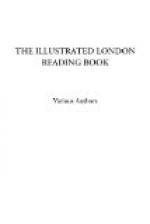On the moor all is bleak and dreary—long, flat, wide, unvarying. The folly and madness of Charles and his followers, in risking a battle on such ground, with jaded, unequal forces, half-starved, and deprived of rest the preceding night, has often been remarked, and is at one glance perceived by the spectator. The Royalist artillery and cavalry had full room to play, for not a knoll or bush was there to mar their murderous aim. Mountains and fastnesses were on the right, within a couple of hours’ journey, but a fatality had struck the infatuated bands of Charles; dissension and discord were in his councils; and a power greater than that of Cumberland had marked them for destruction. But a truce to politics; the grave has closed over victors and vanquished:
“Culloden’s dread echoes are hush’d on the moors;”
and who would awaken them with the voice of reproach, uttered over the dust of the slain? The most interesting memorials of the contest are the green grassy mounds which mark the graves of the slain Highlanders, and which are at once distinguished from the black heath around by the freshness and richness of their verdure. One large pit received the Frasers, and another was dug for the Macintoshes.
Highland Note-Book.
[Illustration]
* * * * *
ATHENS.
The most striking object in Athens is the Acropolis, or Citadel—a rock which rises abruptly from the plain, and is crowned with the Parthenon. This was a temple dedicated to the goddess Minerva, and was built of the hard white marble of Pentelicus. It suffered from the ravages of war between the Turks and Venetians, and also more recently in our own time. The remnant of the sculptures which decorated the pediments, with a large part of the frieze, and other interesting remains, are now in what is called the Elgin collection of the British Museum. During the embassy of Lord Elgin at Constantinople, he obtained permission from the Turkish government to proceed to Athens for the purpose of procuring casts from the most celebrated remains of sculpture and architecture which still existed at Athens. Besides models and drawings which he made, his Lordship collected numerous pieces of Athenian sculpture in statues, capitals, cornices,




